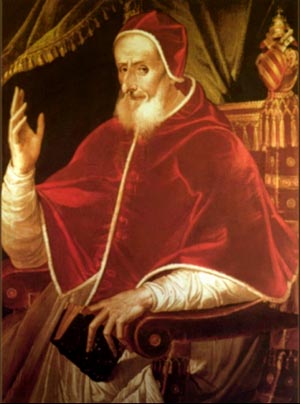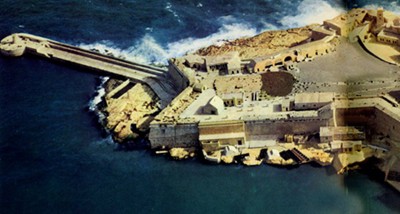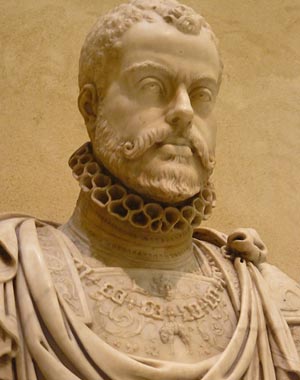 |
The Saint of the Day
Pope St. Pius V - May 5
Prof. Plinio Corrêa de Oliveira
Biographical selection:
In the 16th century, at the time of St. Pius V, the Island of Malta was governed by the Knights of the Order of the Hospital of Saint John. It was a religious military order dating from the Middle Ages, founded in Jerusalem in 1080 shortly before the crusaders conquered the Holy Land. They became known as the Knights Hospitaller or Knights of St. John of Jerusalem.

St. Pius V asked Philip II to assist
the Knights of Malta
|
With the loss of the Holy Land, the Knights of St. John moved to Rhodes, and then to Malta at the beginning of the 16th century. There they stayed until the late 18th century when Napoleon expelled the Order from the Island. They moved their headquarters to Rome, but conserved the name Order of Malta to this day.
At the time of St. Pius V, Malta was an advanced defense position in the European Mediterranean Sea against the Mohammedan ships. Those ships were based in Turkey and North Africa, occupied by Muslim nations. As tensions increased, St. Pius V addressed Philip II, asking support for the Knights of Malta. Here is the first part of the Pope’s letter to the Spanish King:
“To Our Most Dear Son in Christ, Philip II, Catholic King of Spain,
“It is certain and secure that Our most powerful enemy, the Sultan of the Turks, is preparing a large fleet, an armada such as none that ever existed before. He is making these preparations with the intent to assault Malta, destroy the Military Order of Saint John and take possession of the Island. It is said that he is eager to conquer it, both for the great strategic advantage it can offer and to repair for the shame suffered by the Turks in the previous siege.
“Since the Order cannot resist against such enormous forces for long, Our most dear son Jean de la Valette, its Grand Master, is obliged to ask the assistance of the Christian Princes against the common enemy, the enemy of Christendom.
“We do not doubt that Your Majesty and your people will willingly come to help him. It is as much for your own interest to act, so that an island so close to Italy and Sicily will not fall into enemy hands.”
Comments of Prof. Plinio:
This letter has some beautiful aspects. The first is the way the Pope treats King Philip II. He addresses him with these words: “To Our Most Dear Son in Christ, Philip II, Catholic King.” It is beautiful to see how the Popes of that time, following official protocol, could address all the great powers of the earth as a father addresses his sons. He calls “Our most dear son” the man who was one of the most powerful monarchs in the world, a king in whose domains the sun never sets.

The advanced positions of the Fortress of Malta, called Fort St. Elm
|
The title of “Catholic King” is also very beautiful. Throughout History the Holy See granted to various sovereigns titles to glorify them when they achieved great deeds for the Church. Thus, to the King of the firstborn daughter of the Church, France, the Church gave the title of “Most Christian King.” To the Emperor of the Holy Roman Empire, heir of Charlemagne, whose imperial power had been granted by the Church, she gave the title “his Caesarean Majesty;” to the King of Hungary, “his Apostolic Majesty;” to the King of Portugal, “Most Faithful Majesty;” to the King of England, “Defender of the Faith” and to the King of Spain, Rex Catholicus - the “Catholic King,” because Spain had been the Catholic nation par excellence.
You should not imagine that these titles were mere protocol. They also pervaded the practical reality. This letter gives us an example of how the Pope wrote to the King of Spain as a son, giving him a very clear reasoning for his request: “The Knights of the Order of Malta, who are so dear to me and who are the support of Christendom, need help. Therefore, you must assist them.” Nothing could be more clear and simple. If the King of Spain is the Catholic King, then he must come to the aid of those few Catholics who defend all of Christendom.

Rex Catholicus Philip II of Spain
|
What a sharp contrast this makes with the modern States! Today, if we were to have a Pope like St. Pius V - Alas, how far we are from this! - it would be extremely difficult for him to move any temporal head of State to help the Church or Christendom. In that time, how easy it was!
It is true that the Pope also offered an argument for the temporal interest of Spain: he mentioned that the Spanish possessions in Sicily and Italy would be dangerously threatened by the fall of Malta. But, this was a secondary reason. The fundamental motive was that the Catholic Faith and the interests of Christendom would be threatened.
Those were truly happy times. What grand perspectives! How notably the political life was enlightened by a great Faith! We have a strong nostalgia for those times. There is no greater nostalgia than the one we have for those times that we did not even know, but whose atmosphere we can discern by means of our Catholic sense. It is a great nostalgia, a great joy and a great hope that much better times will return for the Church and Christendom.
Since today there are no longer Catholic Kings who can support the Counter-Revolution, on this feast day of St. Pius V, let us ask him to intercede with the Princes of Heaven, the Holy Angels, so that they might come to help those few knights who fight against the enemies of the Church, so much larger in number and means.


  | | Prof. Plinio Corrêa de Oliveira | |
The Saint of the Day features highlights from the lives of saints based on comments made by the late Prof. Plinio Corrêa de Oliveira. Following the example of St. John Bosco who used to make similar talks for the boys of his College, each evening it was Prof. Plinio’s custom to make a short commentary on the lives of the next day’s saint in a meeting for youth in order to encourage them in the practice of virtue and love for the Catholic Church. TIA thought that its readers could profit from these valuable commentaries.
The texts of both the biographical data and the comments come from personal notes taken by Atila S. Guimarães from 1964 to 1995. Given the fact that the source is a personal notebook, it is possible that at times the biographic notes transcribed here will not rigorously follow the original text read by Prof. Plinio. The commentaries have also been adapted and translated for TIA’s site.
|
Saint of the Day | Home | Books | CDs | Search | Contact Us | Donate

© 2002- Tradition in Action, Inc. All Rights Reserved
|
 |

|